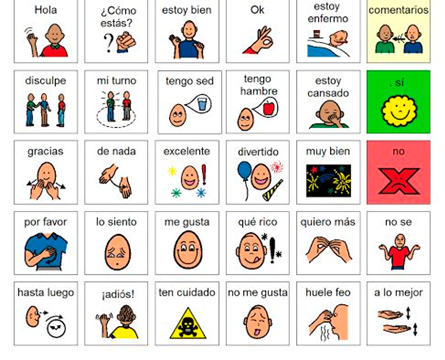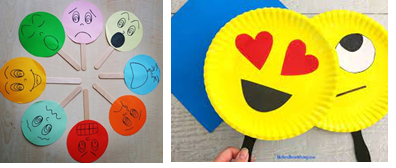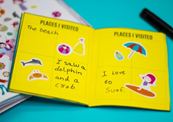Estoy/I Am
WAYS WE CAN USE THE WORD(S)
DIRECT ATTENTION: e.g., Aquí estoy. (Here I am.)
SHARE INFORMATION: e.g., Estoy mojado. (I am wet.) Estoy en el parque. (I am at the park.)
EXPRESS A FEELING: e.g., Estoy triste. (I am sad.)
ANSWER QUESTION: Estoy en cuarto grado. (I am in fourth grade.) Estoy listo. (I am ready.)
AFFIRMATION: Sí, me estoy divertiendo. (Yes, I am having fun.)
CONJUGATIONS FOR PRESENT AND PAST (PRETÉRITO INDEFINIDO)
Infinitive verb: Estar
|
SUBJECT |
PRESENT |
PAST |
|
I |
Estoy |
Estuve |
|
You |
Estás |
Estuviste |
|
He/She/You (Formal) |
Está |
Estuvo |
|
We |
Estamos |
Estuvimos |
|
They/You All |
Están |
Estuvieron |
For specific questions or more ideas regarding this core word activity sheet, please contact Maryvi Morales @ marygm12@gmail.com. Thank you!
Arrival: When students arrive, they can use the word estoy upon their arrival. They can tell their teachers and/or classmates “Estoy aquí maestra/Aquí estoy maestra” (I am here teacher/Here I am teacher)
Snack/mealtimes: During mealtime or snack time, the student can indicate that they are full when an adult asks them if they are done eating e.g. Estoy lleno (I am full).
Circle time: Students can be prompted to identify how they are feeling today. An adult can model this by saying “Hoy estoy muy feliz! Tú cómo estás [Name of student]?
Recess: When students are dismissed for recess, the adult can model the word ‘estoy’ by identifying what they are doing in the playground “Yo estoy jugando futbol! Tu que estas jugando?” (I am playing soccer! What are you playing?)
Toys or Games: While playing with toys or games, students can also use ‘estoy’ to identify what game or toy they are playing with. E.g.,“Estoy jugando con plastilina, quieres jugar conmigo? (I am playing with play dough, want to play with me?), e.g.,“Estoy jugando Bingo” (I am playing bingo).
Here are some suggested books that can assist in teaching the core word:
- Cuando estoy triste: By Trace Moroney|Children’s read aloud
- This story explores how our friend the bunny feels when they are sad. This book can help and teach children how to get through difficult situations, perhaps the loss of a loved one, separation between parents or simple situations in life that may cause them sadness.
- Cuando estoy enfadado: By Trace Moroney | Children’s read aloud
- This story explores how our friend the bunny feels when they are feeling angry. This book can help and teach children how to get through this powerful emotion. It emphasizes that it is okay to feel angry, but it is not okay to hurt someone else because of this feeling. It also provides examples of what one can do when they are feeling this way.
- Estoy creciendo: By Aliki|Children’s read aloud
- This story explores how it is when you are growing up. For example, it talks about how our body changes when we grow and how you grow out of your clothes, etc. Overall, it explains to children how and why we grow.
Bilingual Books:
- When I Am, Cuando estoy: By Gladys Rosa-Mendoza | Children’s Book Read aloud by Read it Again
- This book teaches children vocabulary words for emotions and even suggests constructive ways to deal with some of their negative feelings. The children in the book express a variety of emotions and show/tell how they react. The adult can ask students how they react when they are feeling a certain emotion mentioned in the book and model the use of the word, “Cuando estoy triste, me gusta ver una pelicula. [Name of student] tu que haces cuando estas triste?”
When a student wants to make jokes during class with their friends or teachers, they can be prompted to say “No te creas! Estoy bromeando” or simply “Estoy bromeando” (I am just kidding!)
If a student falls down or is accidentally pushed by classmate during a game and they are fine, they can be prompted to say “Estoy bien” (I am okay)
Here is a sample communication board that provides the word estoy.

During motor activities or PE, students can indicate where they are in terms of location. For example, if they are moving around in the playground, they can be prompted to say “aca estoy en el columpio!” (I am over here on the swing)
Students and adults can use ‘estoy’ to tell their friends what they are doing while they are engaging in their favorite physical activity “Estoy bailando” (I am dancing)
Social skills lesson: Students can match each emotion to its matching emoji card. Teachers can create a lesson on different emotions an individual may experience and ask students what they do or what happens when they feel that emotion and have a discussion. When reviewed together, repeatedly, adults can model the word estoy.
Cómo estás? Estoy..Emotion Matching Cards in Spanish – FREE
Camaleón short story/activity:
Stories are a great way to engage students. An activity could be making copies of the story for the students, having them color it, match the picture with the correct sentence and emphasize the word they are learning today is estoy.
Literacy building activity: The adult can prompt the student to create a short story or poem containing the word ‘estoy.’
- ¿Cómo estás? Sentimientos (How are you? Feelings) |Children’s song | By Rockalingua
- Estoy feliz song |Children’s song |NET Oficial
- Estoy molesto |Children’s song | Pinkfong en español - Canciones Infantiles
- Spirit Aquí estoy |Children’s song | Youtube
- Camaleón dónde estoy? |Children’s song | By Rockalingua
- Use this song to teach Spanish colors and high frequency structures like ¿Dónde estoy? "Aquí estoy" "mira" "busca" and much more!
Art activity: DIY Emotions
Students participate by creating the emotion they are experiencing that day. In this case, paper plates/construction paper were used for the different emotions and popsicle sticks, but there are many other ways to create DIY emotions.

Art activity: Creating a book
Students can bring images/pictures from home and create a book of different places they visited and write “Aqui estoy en Disneyland, Aqui estoy en Arizona” amongst other places they’ve enjoyed visiting and things they have enjoyed from their trip.

WORD WALL: Add the word Estoy on the Word Wall.
READING and the Word Wall: Sound out the letters together. Have the students find the word on the AAC system.
WRITING and the Word Wall: Using a pencil or alternative pencil, have students try to type the word on the keyboard, adapted keyboard or write the word together.